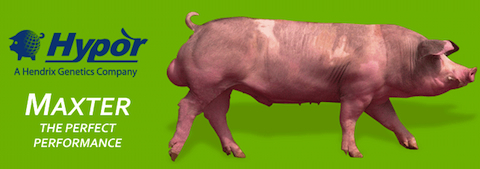
Apologies to my vegetarian readers for what is about to commence: a post about the grisly business of producing pig meat, a delicacy that I seek out far more often than my arteries would like. (I will perform nearly any feat of self-abasement in exchange for some top-notch lechón.)
Though I’m accustomed to reading about expensive cuts of pork, I know little about the industrial system that gives America its much-beloved riblets. And so I was instantly grabbed by a snippet of news making the ag-industry rounds: the Hypor Maxter has arrived:
Hypor is pleased to announce the addition of the Hypor Maxter to its North American terminal boar portfolio. Exceptionally lean, efficient and fast growing, this Piétrain line sits next to Hypor’s Kanto and Magnus Duroc terminal lines (including the DGI and Shade Oak populations). The addition provides producers in Canada and the United States with a comprehensive selection of terminal lines designed to optimise on-farm efficiency while meeting the diverse needs of the North American pork industry.
Originally developed by France Hybrides in 1971, the line was acquired by Hypor in 2008. The Hypor Maxter has achieved widespread commercial success in Europe where it is recognised for being the fastest growing Piétrain in the world. Recent Canadian commercial trials using imported semen have validated European results and demonstrate significant opportunity for the genes in the North American pork value chain. With ever increasing pressure on cost of production, the time was right to introduce the Hypor Maxter line to North America.
Hypor Maxter great grandparent males and females were imported to Manitoba, Canada in July 2010 from Hypor’s Sichamps nucleus in France. Once Hypor and federal inspection processes were complete, the Hypor Maxters were moved from the isolation facility to the Lockport, Manitoba nucleus facility in November 2010. Maxter boars are also being placed in Hypor’s Greenhill Gene Transfer Center and semen will be available for phase two commercial evaluation with strategic partners across Canada and the United States in early 2011.
There’s a lot to chew over here, such as the ethically dicey proposition that a mammalian genetic profile can be transferred between companies like surplus desks. But I’d like to focus on the upshot of the Hypor Maxter’s North American rollout: continued access to dirt-cheap pork, for better and for worse. The Maxter’s chief selling point is its growth potential—that is, it gets mighty huge in a relative hurry, thereby keeping producer costs in check. But the meat quality seems to be in question, as evidenced by this 2003 study comparing Pietrains to Durocs:
Subjective meat quality scores for color, marbling, and firmness (1 to 5 scale) were more favorable for Duroc-sired progeny. Furthermore, chops from Duroc progeny had higher 24-h pH (5.53 vs. 5.48, P < 0.001) and Minolta a* (17.33 vs. 17.04, P < 0.05) with less percentage drip loss (2.88 vs. 3.80, P < 0.001). No differences were detected between Duroc- and Pietrain-sired progeny for Minolta L* (54.77 vs. 55.37) or b* (7.58 vs. 7.58) objective color scores, percentage cooking loss (28.63 vs. 29.23), or Warner-Bratzler shear force (6.94 vs. 7.11 kg).
So expect your pan-fried dumplings to remain vanishingly cheap in the coming years, thanks to the blessings of science. But speaking for myself alone, I won’t be able to tuck into cheap pork with quite the same abandon knowing that I’m feasting upon a slice of Hypor’s “terminal boar portfolio.”


william // Feb 2, 2011 at 12:06 pm
I’m not much into pork, (although I do enjoy al pastor tacos) but I was fascinated by the stilted technical jargon in your quoted article: “terminal boar portfolio”, “North American pork value chain”, and “Manitoba nucleus facility”.
Brendan I. Koerner // Feb 2, 2011 at 12:31 pm
@william: “Terminal boar portfolio” is my favorite. Tremendous euphemism for owning a bunch of pork-pig genes.